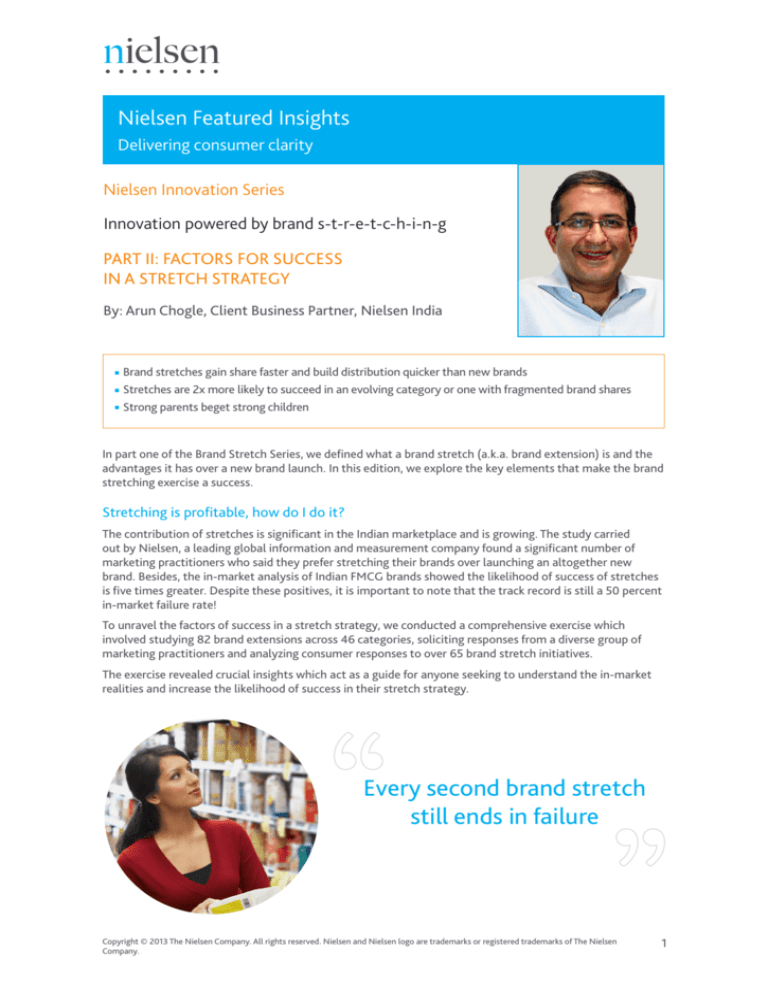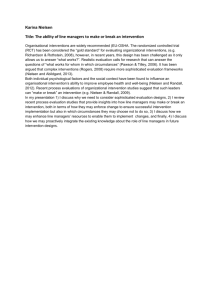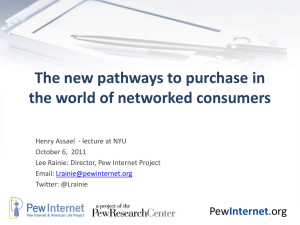
Nielsen Featured Insights
Delivering consumer clarity
Nielsen Innovation Series
Innovation powered by brand s-t-r-e-t-c-h-i-n-g
PART II: FACTORS FOR SUCCESS
IN A STRETCH STRATEGY
By: Arun Chogle, Client Business Partner, Nielsen India
Brand stretches gain share faster and build distribution quicker than new brands
Stretches are 2x more likely to succeed in an evolving category or one with fragmented brand shares
Strong parents beget strong children
In part one of the Brand Stretch Series, we defined what a brand stretch (a.k.a. brand extension) is and the
advantages it has over a new brand launch. In this edition, we explore the key elements that make the brand
stretching exercise a success.
Stretching is profitable, how do I do it?
The contribution of stretches is significant in the Indian marketplace and is growing. The study carried
out by Nielsen, a leading global information and measurement company found a significant number of
marketing practitioners who said they prefer stretching their brands over launching an altogether new
brand. Besides, the in-market analysis of Indian FMCG brands showed the likelihood of success of stretches
is five times greater. Despite these positives, it is important to note that the track record is still a 50 percent
in-market failure rate!
To unravel the factors of success in a stretch strategy, we conducted a comprehensive exercise which
involved studying 82 brand extensions across 46 categories, soliciting responses from a diverse group of
marketing practitioners and analyzing consumer responses to over 65 brand stretch initiatives.
The exercise revealed crucial insights which act as a guide for anyone seeking to understand the in-market
realities and increase the likelihood of success in their stretch strategy.
Every second brand stretch
still ends in failure
Copyright © 2013 The Nielsen Company. All rights reserved. Nielsen and Nielsen logo are trademarks or registered trademarks of The Nielsen
Company.
1
Finding 1
STRETCHES
GAIN
SHARE
FASTER
Brands
Body
Lotions
Oats
Market Share
New: 87
National: 8
0.3%
Extension: 8
National: 7
4.0%
New: 56
National: 3
0.4%
Extension: 4
National: 1
9.6%
+3.7%
+9.2%
Source: Nielsen
The existing reputation of the parent brand helps extensions gain market share faster than new launches. In
the illustration above, in the Body Lotions category, eight new brands went national and achieved a share of
less than 0.3 percent while the seven brand extensions in the same period of review gained a market share
of nearly four percent.
Similarly in the Oats category, one single brand stretch gained 9.2 percent more compared to the three
new brands that went national. Both examples are typical of most other categories we studied suggesting a
faster consumer trial and adoption process.
Not only do stretches gain share faster, they build distribution quicker. We looked at how long it takes a
new brand to build distribution versus a brand extension. Comparing two large companies with similar sales
infrastructures, we observed that brand extensions had two-and-a-half times faster growth in distribution
in the same period. This suggests it is not just the result of leveraging past equity in the minds of consumers
but also the positive reputation and experience with channel partners.
The Caveat: Each brand and its category has its own existing distribution footprint. Marketers should avoid
the temptation of building a distribution strategy based solely on the footprint of its parent brand simply
because it is easier. We found that four out of five successful stretches were able to get into at least 30
percent of the top-end stores of the new category.
Finding 2
STRETCHES ARE
2X MORE LIKELY
TO SUCCEED IN
A HIGHLY
FRAGMENTED
CATEGORY
Fragmented
Categories
More players &
smaller shares
Evolving
Categories
Less than
Rs. 1800 crores
Source: Nielsen
Copyright © 2013 The Nielsen Company. All rights reserved. Nielsen and Nielsen logo are trademarks or registered trademarks of The Nielsen
Company.
2
Two distinct patterns emerged when we examined the link between a stretch category structure and
success:
a. Stretches introduced in fragmented categories (a lot of brands with small market share) are twice as likely to succeed compared to categories which have just a few dominant players.
b.
Similarly, there is a greater chance of success in entering categories that are evolving and where brands haven’t fully penetrated. Early adopters have tried the brand but usage behaviour is still forming amongst consumers. Examples of such categories include breakfast cereals. We found more
successful stretches where the category size is smaller i.e. less than Rs 1800 crore
versus those of over Rs 3100 crore.
Finding 3
65% OF
SUCCESSFUL
STRETCHES
HAVE A PRICE
PREMIUM
INDEX LOWER
THAN PARENT
Successful
Parent Brand
Less Successful
117
121
134
Average premiumization index to category
Source: Nielsen
Conventional wisdom would suggest that parent brands should be able to command a price premium with
brand extensions in new categories. However, our analysis suggested quite the opposite.
In the sample of brands we observed, parent brands had a Price Premium Index* of 121. Two out of three
stretches that were successful had a lower average premium of 117 versus unsuccessful stretches which had
a higher average premium. Brands that got greedy and charged a premium higher than that of its parent,
had a lower chance of success. In some examples of success we noticed that marketers went in with a lower
introductory promotional pricing and later moved to a higher band.
*Price Premiumization Index is defined as average price of brand to average price in the category
Finding 4
STRONG
PARENTS
BEGET
STRONG
CHILDREN
41%
Parent Brand
in top 5 players
in category
59%
Successful Brand Extensions
65%
Parent Brand
not in top
5 players
35%
Less Successful Brand Extensions
Source: Nielsen
Copyright © 2013 The Nielsen Company. All rights reserved. Nielsen and Nielsen logo are trademarks or registered trademarks of The Nielsen
Company.
3
Building the core is important. One cannot stretch a
brand into a new category unless it has built equity and
reputation in its parent category. We found that parent
brands which are in the top five on sales revenue have a
greater probability to succeed compared to stretches of
parents which are not in the top five.
Marketers who are able to creatively capitalize on these
learnings are more likely to create a compelling formula to
successfully make the brand extension journey.
The next step
The factors of success constitute a fundamental base for
understanding the elements that have worked on effective
stretches in the FMCG space. In the next part, we propose
a framework you can apply by combining advantages of
market structure, company competence and leveraging the
power of the brand using the four ‘ARRC factors’ to help
you plot winning strategies.”
Coming up in part-III of the Innovation Powered by Brand Stretch series:
FRAMEWORK TO MAKE BRAND STRETCH WORK FOR YOU
Innovation powered by brand s-t-r-e-t-c-h-i-n-g is a multi-part series of Nielsen’s thought leadership on
Innovation. The series focuses on the power of brand extensions as an effective innovation strategy to win in
the Indian marketplace. Nielsen would like to thank our client contributors & industry practitioners who were
instrumental in the co-creation of this thought leadership. The author would also like to thank Vishal Anam from
Nielsen Mumbai for his analytical contributions to this series.
About Nielsen
Nielsen Holdings N.V. (NYSE: NLSN) is a global information and measurement company with leading
market positions in marketing and consumer information, television and other media measurement,
online intelligence, mobile measurement, trade shows and related properties. Nielsen has a presence in
approximately 100 countries, with headquarters in New York, USA and Diemen, the Netherlands.
For more information, visit www.nielsen.com.
Copyright © 2013 The Nielsen Company. All rights reserved. Nielsen and Nielsen logo are trademarks or registered trademarks of The Nielsen
Company.
4








